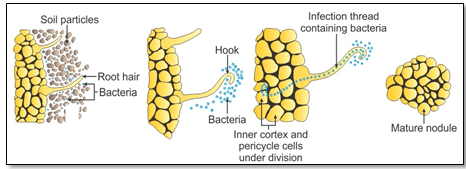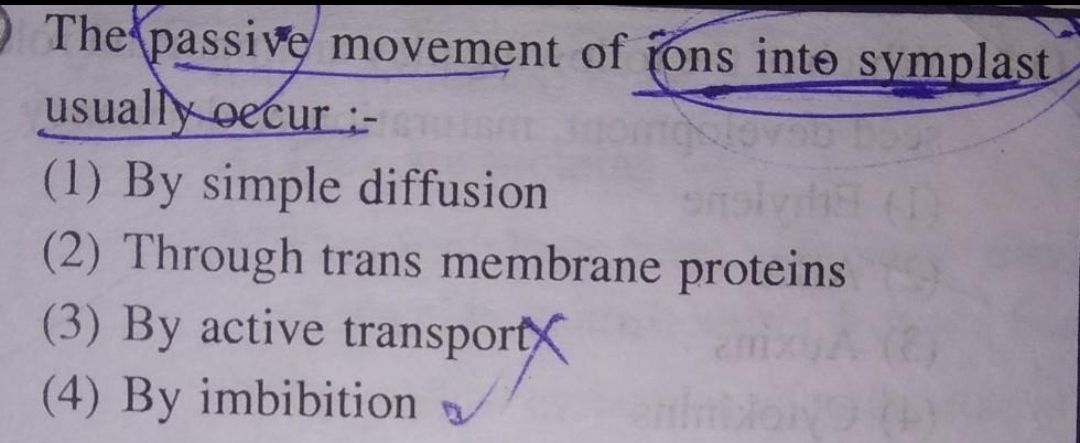Mineral Nutrition
Mineral Nutrition PDF Notes, Important Questions and Synopsis
SYNOPSIS
- Absorption, distribution and metabolism of various mineral elements by plants is called mineral nutrition.
- Methods to Study the Mineral Requirement of Plants
- Hydroponics: Technique of growing plants in a nutrient solution.
- Aeroponics: Technique of growing plants without a growing medium.
- Sand Culture: Sand is used as rooting medium and nutrient solution is added to it.
- Physiological Role and Deficiency Symptoms of Macronutrients and Micronutrients
Macronutrients are used in relatively large amounts by plants for their growth.
Macroelement
Physiological Role
Deficiency Symptoms
Nitrogen
- Absorbed mainly as NO3−, NO2−, NH4+.
- Chief constituent of proteins, nucleic acids, amino acids, purines.
- Yellowing of leaves and development of chlorosis.
Sulphur
- Absorbed in the form of SO42− ions.
- Determines protein structure.
- Young leaves become chlorotic, anthocyanin pigmentation.
Phosphorus
- Absorbed in the form of H2PO4− or HPO42− ions.
- Acts as an activator of some enzymes.
- Disruption of general metabolism.
- Abnormalities in the shape and size of chloroplasts.
Calcium
- Absorbed in the form of Ca2+ ions.
- Essential for chromatin or mitotic spindle organisation.
- Margins of younger leaves show chlorosis.
Potassium
- Absorbed as K+ ions.
- Regulates stomatal movement.
- Weak stalks are developed.
Magnesium
- Absorbed in the form of Mg2+ ions.
- Helps in photosynthesis.
- Yellowing of leaves.
- Tips and margins of leaves turn upwards.
Micronutrients are required by plants in minute quantities.
Microelement
Physiological Role
Deficiency Symptoms
Iron
- Absorbed in the form of Fe3+ ions.
- Plays an important role in electron transport systems.
- Development of characteristic chlorotic spots and the veins remain green.
Boron
- Absorbed as BO33− or B4O72−.
- Regulates carbohydrate metabolism.
- Deformation, discolouration and disorganisation of meristematic tissue.
Manganese
- Absorbed in the form of Mn2+ ions.
- Plays a role in photo-oxidation of H2O and release of molecular O2.
- Chlorosis and necrosis in the interveins of leaves.
Copper
- Absorbed in the form of Cu2+ ions.
- Plays a key role in the electron transport chain in photosynthesis.
- Distortion and chlorosis in leaves followed by necrosis of the tips of young leaves.
Zinc
- Absorbed in the form of Zn2+ ions.
- Plays an important role in the synthesis of auxins.
- Shortening of internodes resulting in stunted plant growth.
- Suppression of seed formation.
Microelement
Physiological Role
Deficiency Symptoms
Molybdenum
- Absorbed in the form of MoO22+ ions.
- Required for nodulation in legumes, synthesis of tannins and reduction of nitrates to nitrites.
- Development of chlorosis along with poor leaf growth.
- Reduction in nitrogen fixation in symbiotic plants.
Chlorine
- Absorbed in the form of Cl− anions.
- Essential in the transport of electrons from water to photo oxidised chlorophyll.
- Wilted leaves, which then become chlorotic and necrotic.
Nickel
- Catalyses the hydrolysis of urea to CO2 and NH4.
- Development of necrotic spots at the tips.
- The process of conversion of free nitrogen (N2) to ammonia (NH3) to make it available for uptake by plants is called nitrogen fixation.
- Rhizobium fixes atmospheric nitrogen in symbiotic association with the roots of leguminous plants.
- Nodules act as sites for nitrogen fixation because they contain the enzyme nitrogenase and pigment leghaemoglobin essential for fixing atmospheric nitrogen.
- Nitrogenase is a Mo–Fe protein which catalyses the conversion of atmospheric N2 to NH3.

- At physiological pH, ammonia is protonated to form ammonium (NH4+) ions.
- In legumes, ammonia is assimilated into amino acids, amides or ureides.
Download complete content for FREE 
NEET - Biology
Asked by vikashkumaryadav2104 | 03 Oct, 2020 12:14: PM
NEET - Biology
Asked by dpranjali579 | 27 Sep, 2020 07:46: PM
NEET - Biology
Asked by jhajuhi19 | 27 Mar, 2020 06:39: PM
Related Chapters
- The Living World
- Biological Classification
- Plant Kingdom
- Animal Kingdom
- Morphology of Flowering Plants
- Anatomy of Flowering Plants
- Structural Organisation in Animals
- Cell : The Unit of Life
- Biomolecules
- Cell Cycle and Cell Division
- Transport in Plants
- Photosynthesis in Higher Plants
- Respiration in Plants
- Plant Growth and Development
- Digestion and Absorption
- Breathing and Exchange of Gases
- Body Fluids and Circulation
- Excretory Products and their Elimination
- Locomotion and Movement
- Neural Control and Coordination
- Chemical Coordination and Integration
- Reproduction in Organisms
- Sexual Reproduction in Flowering Plants
- Human Reproduction
- Reproductive Health
- Principles of Inheritance and Variation
- Molecular Basis of Inheritance
- Evolution
- Human Health and Disease
- Strategies for Enhancement in Food Production
- Microbes in Human Welfare
- Biotechnology : Principles and Processes
- Biotechnology and its Applications
- Organisms and Populations
- Ecosystem
- Biodiversity and Conservation
- Environmental Issues



